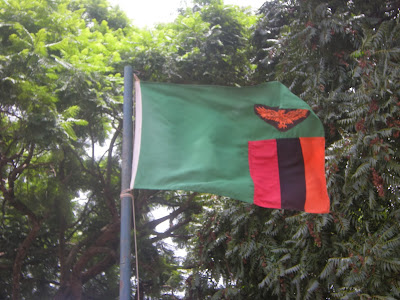 |
| The Zambian Flag |
Anyway, the flag, or the colours of it are as above seen fluttering down some street somewhere and the reasons for each are something like as follows:
- Green: Prety obvious really when you get there. A lot of plants grow very quickly in Zambia, during the rainy season, and they need them to, quite badly. If the rains fail, and they did in recent memory, a year in the 90's I think, and the country was a bit buggered. There is a fine and fragile line here. There is a lot of wild bush where the elephants live. Giraffes and literally tonnes of hippos. There are literally about two and very precious as a result, balck rhinos. All their mates and ancestors have been wiped out someway or another.
- Orange: is for the seams of natural copper that are found in the north central and resulting main industrial area of the country, the Copperbelt This, I believe, and all future rights to any more ever found has been sold to the Chinese. Copper ore also contains all the silver and gold in the country too and this was like a free gift with the copper. I'n no business man but the move doesn't strike me as the shrewdest.
- Black: this represents the Bantu people of southern Africa.
- Red: is the colour of the blood of the Bantu people that has been bled here and there in history, notably in the case of the Zambian flag, during the move towards independence in the second half of the last century. It wasn't the bloodiest of transitions but there were riots and people died. I don't know that much about it.
- Eagle: the Sea Eagle is the national bird of Zambia. Although there is no sea there are loads of Sea Eagles in the branches of the trees that line the Zambezi. That's where I've seen them. They sit up there looking like the national bird. I don't know anything more about the sea eagle and neither did anybody else in the class that I asked apart from them being brown feathers on the body with a white neck and head. People don't seem to get as excited as we do in this country about wildlife. It's not that they take it for granted, it's more like they just coexist peacefully with it. It's almost just there with them, or down the road. The regular victims of crocodile attacks don't though. Saying that, there is a zoo in Lusaka that I haven't been too, don't know who does and can't really get my head round but then there's a few things like that. It's true though.

No comments:
Post a Comment